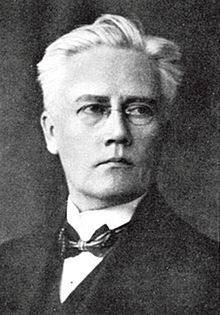Herman Lundborg
Herman Bernhard Lundborg (born April 7, 1868 in Väse , Karlstad municipality , † May 9, 1943 in Östhammar ) was a Swedish racial theorist , neurologist and psychiatrist. He was the founder and director of the State Institute for Racial Biology in Uppsala from 1922 to 1935.
Life
Lundborg studied at Stockholm University from 1887 . In 1902 he received his doctorate at Lund University and in 1903 was a lecturer in psychiatry and neurology at Uppsala University , from 1915 on racial biology and medical genetics.
Herman Lundborg was at the center of Swedish racial biology . His views on race theory followed the tradition of Swedish folk ideology, which had developed in the 19th century under the influence of Arthur de Gobineau and Houston Stewart Chamberlain . After that, the folk was to be kept healthy as a pure and homogeneous racial body, since mixing with other races led to the deterioration of the genetic makeup. Persons deviating from this norm should be rendered harmless. Lundborg was of the opinion that certain ethnic groups are unfit for race, e.g. B. Sami ("rags") , blacks and Jews . Lundborg's research measured skulls and body features with the aim of determining racial affiliation. He undertook numerous expeditions to Lapland and Finland to measure and photograph people and based on external characteristics, from baptismal and criminal records, his race theory was developed.
Lundborg actively campaigned for the establishment of a state institute for racial biology and a law for “eugenic sterilization”. In 1921 he was appointed professor and director of the newly established State Institute of Racial Biology at Uppsala University, the aim of which was to study the characteristics of valuable breeds .
Herman Lundborg had a leading role in the German racial hygiene movement as early as the early 1910s. It was a small, influential circle of men who later became well-known racial hygienists of National Socialist Germany. These included Ernst Rüdin , Fritz Lenz , Eugen Fischer (physician) and Alfred Ploetz . When Hitler took power in 1933, they were able to implement the ideas that had formed their common vision of a “modern population improvement” - a “biological policy” - for more than 20 years. He was also involved in the journal for human inheritance and constitutional theory published by Günther Just and Karl Heinrich Bauer from 1935 onwards .
In 1934 he was elected a member of the Leopoldina . Lundborg was co-editor of the magazine for racial studies founded by Egon von Eickstedt in 1935 , which ceased publication in 1944.
The Unverricht-Lundborg disease is named after him.
Trivia
Lundborg appears as a supporting character in the novel The Hundred Year Old Who Climbed Out the Window and Disappeared by Jonas Jonasson , and in the feature film based on it. Lundborg itself is described rather satirically here. The main character of the novel is forcibly sterilized in Lundborg's clinic, but this is portrayed in the ironic manner typical of the novel.
Web links
- Literature by and about Herman Lundborg in the catalog of the German National Library
- Herman Lundborg . In: Theodor Westrin, Ruben Gustafsson Berg, Eugen Fahlstedt (eds.): Nordisk familjebok konversationslexikon och realencyklopedi . 2nd Edition. tape 37 : Supplement: L – Riksdag . Nordisk familjeboks förlag, Stockholm 1925, Sp. 322 (Swedish, runeberg.org ).
- Forum för levande historia : Rasbiologist i Sverige ( Memento from January 8, 2011 in the Internet Archive ) (PDF; 221 kB) (Swedish)
- Biographical book " Käraste Hermann " by Maja Hagermann, based on the Lundborg letter archive of Uppsala University (in Swedish). Published 2015, ISBN 978-91-1-305947-1 .
- Website of the author Maja Hagermann on Hermann Lundborg's influence on German racial ideology in the early 20th century.
Individual evidence
- ↑ Member entry by Herman B. Lundborg at the German Academy of Natural Scientists Leopoldina , accessed on February 15, 2016.
| personal data | |
|---|---|
| SURNAME | Lundborg, Herman |
| ALTERNATIVE NAMES | Lundborg, Herman Bernhard (full name) |
| BRIEF DESCRIPTION | Swedish racial theorist |
| DATE OF BIRTH | April 7, 1868 |
| PLACE OF BIRTH | Väse , Karlstad (municipality) |
| DATE OF DEATH | May 9, 1943 |
| Place of death | Osthammar |
